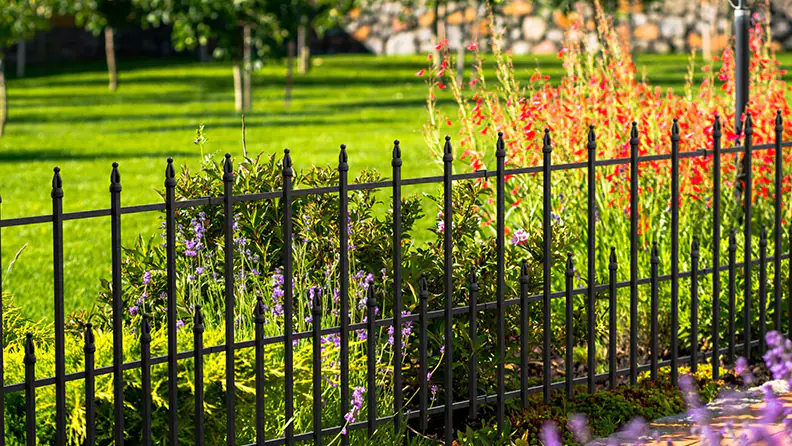Table of Contents
After designing your perfect garden, with clever planting, garden furniture and ornaments, you will need to find an appropriate material to border your space. But what do you choose? There are many factors to consider, from the long life of the material to the overall aesthetics, and of course, whether it fits within your budgetary limitations. Though timber fencing is still the most popular choice, there are many different options on the market, from concrete panels, brick walls and artificial composite fencing. Below, we will explore your options for garden fencing in detail, to give you a clearer understanding of what’s available to you. Let’s take a look…
Timber
Timber is still the standard option for most homeowners looking to construct garden fencing or decking. Its main benefit is it’s natural, rustic appearance, which perfectly blends with any planting. Additionally, it’s lightweight qualities make timber fences relatively easy to install, especially if you are embarking on a DIY project as opposed to hiring a professional installer. Timber fences are also particularly friendly for the budget conscious, at least in the short term.
However, there are many disadvantages to timber fencing. Though initially low cost, essential maintenance tasks such as painting and preserving can be incredibly expensive, not to mention time consuming, as they will need to be performed on an annual basis to protect the integrity of the material. Though it is lightweight, the downside to this is that it can be easy to damage, both from external pressure from neighbours, and high winds uprooting your fencing entirely from its foundations.
Brick
Where better to look for fencing inspiration than at home? A brick wall is a sure-fire way to ensure a long-lasting garden border that perfectly matches the look and feel of your house. Highly soundproof and structurally solid, a brick wall easily provides you the much-desired garden privacy you need. You do not even need to necessarily choose a more modern red brick for your border and can instead opt for a softer colour with sandstone.
A downside to a brick-built border is that it can be incredibly expensive. As well as this, its longevity can be a double-edged sword; once built, it cannot be moved or modified without being demolished first. There is also the potential that your garden may become too private with a brick wall, with your fencing potentially limiting airflow and light from entering your garden space, depending on how high your border is built.
Concrete
Like a brick border, the advantage of concrete is the soundproofing qualities that it provides, as well as the structural stability afforded by such a tough material. Due to their sheer weight, concrete fences can be difficult to install, often needing multiple people to lift your panels. However, once built, they are remarkably durable, and require very limited maintenance to keep them looking their best, needing only a quick spray with a hose or pressure washer every couple of months to remove and surface marks.
Whilst some concrete fencing has been designed to appear more natural, with artificial brick or woodgrain textures etched into the surface, the reality is that a lot of concrete fence options are not as visually attractive as the other fencing options on the market and can instead leave your garden appearing more industrial. This is great for bordering the space of a business, but may not give a warm, welcoming vibe and feeling for your home and garden. Furthermore, concrete is also not a great material in terms of sustainability, with its manufacture massively contributing to global CO2 emissions.
Artificial Fencing
Artificial fencing has earned an unfortunate reputation as being cheap and nasty due to the brittle PVC fence panels of yesteryear. Additionally, if your artificial fencing is not imbued with UV inhibitors, the colour of your fencing panels can rapidly fade when exposed to sunlight, making them appear tired and aged. This can make your fencing look far more fragile and flimsier looking than when compared to timber, brick, or concrete options. There are more premium, high quality plastic fence solutions available, that are far sturdier and more natural looking, but these will be more expensive.
Thankfully, alternatives have been made in the world of artificial fencing, both in terms of looks and longevity, with the introduction of composite fencing. Composite fencing is made up of recycled timber and plastic fibres. The advantage of this material is that it retains the texture of real wood but retains the long-life qualities of plastic. With both slatted and woodgrain composite fencing on the market, and with a range of colours and decorative screens to choose from, composite fencing offers you a customisable, modular solution to fit any space.
Decorative Elements
A factor which may sway your decision-making process is how customisable your fence material is once you have installed it. Timber can be painted, meaning your garden fencing can be any colour you want, from modern grey and black finishes to something more personalised and individualistic, like pastel toned blues and greens. Wooden or natural stone fences are great for decorating with trellises, which allow you build upwards with clever vertical planting. Drilling into the surface of brick or concrete may be slightly more cumbersome, whereas drilling into composite fencing is likely to damage the capped polymer surface entirely, which will void the warranty of the material.
Like trellises, decorative metal screens are a fantastic decorative element to install onto your fencing. They can give a bland panel surface a much-needed visual variety or texture and can inject a sense of character into your space. As stated, some composite fencing brands allow you to easily slot your metal screens into place using specially designed metal inserts. Metal screens provide you with the same sense of privacy as a completed fence but serve the added functional purpose of allowing lighter and airflow into your space, so your garden can feel more oxygenated, and less cut off from the world.





